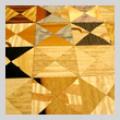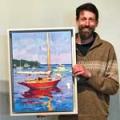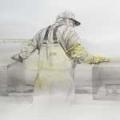Reed Hayden
Woodcarver, folk artist, sign maker
Photographs by Stephen Rappaport
 Wood and steel, and spectacles too, all are the tools of the trade of master woodcarver and sign maker Reed Hayden.
Wood and steel, and spectacles too, all are the tools of the trade of master woodcarver and sign maker Reed Hayden.
Head out a narrow, woods-shaded country road winding past farmland and bogs on the Blue Hill Peninsula and, just before the road crosses a meandering stream, you will find the Hayden Sign Company and Reed Hayden’s workshop—if you don’t miss the unmarked driveway.
Unmarked by design, and easy for the casual visitor to miss, the narrow dirt driveway leads to the sign company’s shop building and, beyond it, to the home of master woodcarver and sign maker Reed Hayden and his family. The absence of any sign assures them some privacy; and most customers, familiar with Hayden and his work, know how to find him. Those customers include many custom boatbuilders.
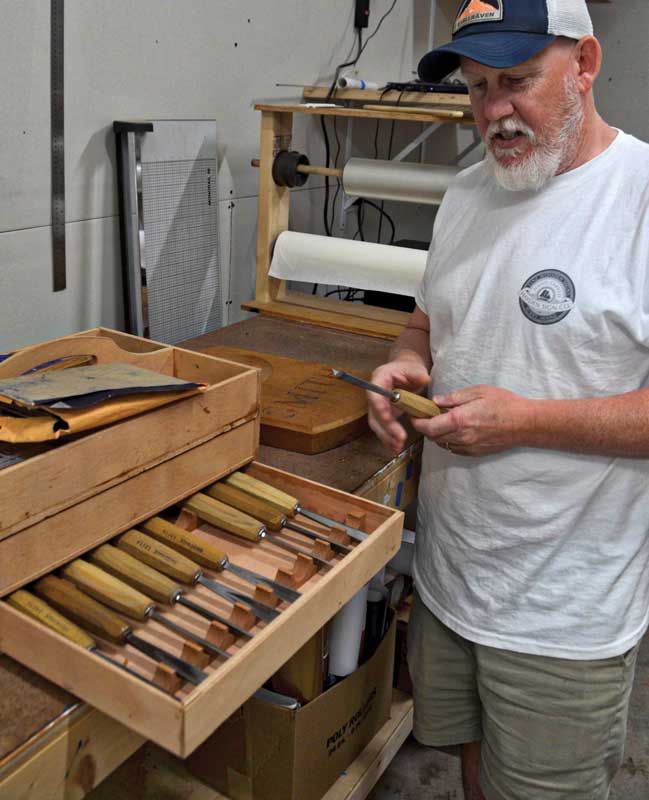 Hayden uses Pfeil wood gouges to carve the unique signs he creates as well as for trail boards, decorative scrollwork, and transoms for custom built boats.
Hayden uses Pfeil wood gouges to carve the unique signs he creates as well as for trail boards, decorative scrollwork, and transoms for custom built boats.
While Hayden says he can make just about any kind of sign, including ordinary vinyl letters for boat names, painted signs for businesses, and lettering for vehicles, his specialties are exquisite hand-carving in wood and the art of gold leafing. Those skills have kept him busy with nautical projects—he’s carved elegant, decorative scrollwork on fine wooden boats, and gold-leafed boat names on wood transoms for just about every high end, custom boatbuilder and restorer in Maine. Hayden also creates classic carved wood signs for businesses ashore.
A Cape Cod native, Hayden was bitten by the art bug in high school. “I was voted the most artistic, or something,” he said. He studied art at the University of Massachusetts in Dartmouth. Eventually, he earned a Master of Fine Arts degree as a sculptor, working while in school to support his wife and children. Initially, he banged nails building houses during the busy Cape Cod real estate boom, but his interest in art ultimately led him to his current multifaceted career.
 A work in progress: a new transom for the recently completed restoration of the historic schooner Hindu, a near sister ship to the Arctic schooner Bowdoin.
A work in progress: a new transom for the recently completed restoration of the historic schooner Hindu, a near sister ship to the Arctic schooner Bowdoin.
Hayden was working at a conservation area called Seabury Farm where one of his co-workers carved the business name into a wooden drop board used on a farm truck. That “really piqued my interest,” Hayden said, “because I was into art and into hands-on things.”
He sought out an apprenticeship with the Sandwich, Massachusetts, woodcarver Paul White and wound up working for local woodcarver and sign maker Doug Amidon. “I asked if I could work for him and he sort of blew me off,” Hayden said. “I was persistent, and he finally hired me and that’s where I actually learned sign carving.”
Amidon’s shop specialized in making signs with what Hayden described as “this very Cape Cod, New England aesthetic of carved gold leaf, black and gold” that is found at countless businesses lining the historic “Old King’s Highway,” Route 6A, as it winds along Cape Cod’s north shore. Hayden worked at Amidon’s for five years, eventually becoming the shop’s principal sign carver.
“We had these big carved signs,” Hayden said. “Other people would build the signs and lay them out. So, there’d be days when I would just walk in with my tools, and I would just carve letters for eight hours straight.”
Eventually, Hayden took his carving skills, his knowledge of carpentry, and a lifelong interest in boats—his first job, at age 12, was on the docks of Baxter’s Wharf in Hyannis Harbor—to Ballentine’s Boat Shop in nearby Cataumet. There, he learned all about meticulous boat carpentry and got his first chance to letter a boat’s transom in gold leaf. He also carved his first name boards for boats. Those skills eventually, after a short stint at Hinckley and a brief return to Amidon’s shop, led Hayden to Brooklin Boat Yard where he spent 15 years as a boat carpenter and wood carver.
For the past five years, Hayden has run his own business, concentrating entirely on signs. While he doesn’t have a sign on the roadside, he does have an elaborate website displaying his work (haydensign.com). Although Hayden can make any kind of sign using commercial techniques—printing and cutting vinyl letters and lettering trucks are on his list of services—making hand-carved wooden signs, painted and often finished with gold leaf, is his specialty.
He uses an ordinary commercial paint on his wooden signs, but the application of gold leaf—whether to a picture frame, a carved, land-based sign, or the lettering on a boat transom or name board—is an art in itself.
Two kinds of gold leaf—surface gold and patent gold—are used for gilded wood carvings and lettering; the choice depends on the use. Both are real 23-karat gold, but surface gold comes as a loose powder and is generally used indoors, where it won’t literally blow away, primarily to decorate dimensional carvings. Patent gold that is attached to a backing sheet is used mostly for outdoor projects such as lettering boat transoms. Both forms of gold leaf are applied to a sticky sizing spread on the work surface, then burnished with a soft brush similar to one used to apply rouge.
Unlike many traditional carvers who work with soft white pine as a medium, Hayden uses African mahogany, a much harder wood, for most of his carving. The project might entail a scroll or a traditional pinecone as a decorative element, but Hayden concentrates a lot on letter carving.
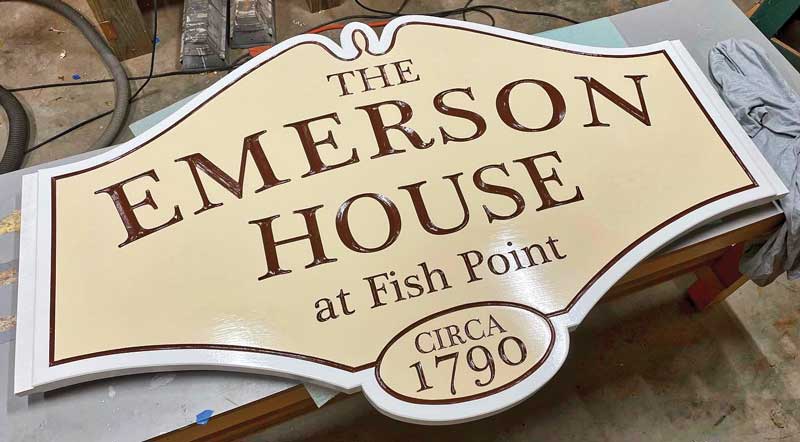
 ...transom of a boat built at the Apprenticeshop...
...transom of a boat built at the Apprenticeshop...
 ...and another restored at Brooklin Boat Yard for which he designed, gilded, and painted the name and hailing port.
Using a harder wood and that concentration on letters require a unique technique. Hayden said he is one of just a handful of carvers who uses it. Most New England carvers, he explained, use a traditional folk-art style, essentially whittling and paring the wood. “They developed these blunt knives. They used white pine, so you don’t have to chop letters in.”
...and another restored at Brooklin Boat Yard for which he designed, gilded, and painted the name and hailing port.
Using a harder wood and that concentration on letters require a unique technique. Hayden said he is one of just a handful of carvers who uses it. Most New England carvers, he explained, use a traditional folk-art style, essentially whittling and paring the wood. “They developed these blunt knives. They used white pine, so you don’t have to chop letters in.”
Hayden’s work does involve “chopping” the letters he carves using V-shaped Pfeil wood gouges and hardwood mallets. On his workbench currently are an oak mallet and one that he built from an offcut of a laminated mahogany boat stem. He uses pairs of the V-shaped tools as if they were two conjoined chisels, rather than simple gouges.
“There’s a whole technique that I go through in my class to teach it,” he said, noting that this was his 18th summer teaching wood carving at the WoodenBoat School in Brooklin. “It is sort of a unique approach,” he added. “It’s like the culmination of this evolution of this folk art.”
✮
Stephen Rappaport is a writer and editor, has lived in Maine for more than 30 years, and is a lifelong sailor.
Hayden Sign Company
Surry, ME
207-812-2570
www.haydensign.com
Related Articles
Share this article:
2023 Maine Boat & Home Show

Join Us for the Maine Boat & Home Show!
Art, Artisans, Food, Fun & Boats, Boats, Boats
August 11 - 13, 2023 | On the waterfront, Rockland, Maine
Click here to pre-order your tickets.
Show is produced by Maine Boats, Homes & Harbors magazine.







